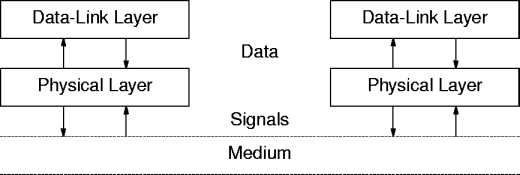The Physical Layer
- The physical layer is responsible for moving bits from here to there.

- The physical layer abstracts the transmission medium for
the data-link layer.
- Given two systems connected by a medium, how can you send bits from one
system to the other?
Connection Media
- Different media, with end-point electronics and optics, determine media
properties.
- And that effects how you send data.
- Of what does this intra-system medium consist?
- Shoe leather (sneaker net).
- Twisted pair (The category or cat cable).
- Coaxial cable (coax).
- Optical fiber.
- Radio waves.
- Infrared.
Physical-Layer Properties
- Encodings turn data (bits) into signal.
- Simultaneous data flow is determined by "duplexivity".
- Half-duplex is one-way data flow.
- Full-duplex is two-way data flow.
- Data rates measure information per unit time.
- Operating constraints under which the medium performs.
Link Examples
| Medium | Bandwidth | Distance |
|---|
| Cat 5 twisted pair | 10-1,000 | 100 m |
| 50-ohm coax (thinwire) | 10-100 | 200 m |
| 75-ohm coax (thickwire) | 10-100 | 500 m |
| Multimode fiber | 100 | 2 km |
| Single-mode fiber | 100-2,400 | 40 km |
Physical-Layer Services
| Service | Bandwidth |
|---|
| B-channel ISDN | 64 Kbps | |
| T1 (DS1) | 1.544 Mbps | |
| T3 (DS3) | 44.736 Mbps | |
| STS-3 (OC-3) | 115.251 Mbps | |
| STS-12 (OC-12) | 722.08 Mbps | |
| STS-24 (OC-24) | 1.24416 Gbps | |
| STS-48 (OC-48) | 2.28832 Gbps | |
Data Rates
- The principle measure of media is data rates.
- But what's the units: bits or bauds or Hertz?
- Alternatively, are we measuring data or signal or bandwidth?
- The bandwidth of the medium measured in Hertz.
- Signal modulations are measured in bauds.
- The medium bandwidth limits the signal baud rate.
- A set of signal modulations represent a bit.
Signals and Uncertainty
- It begins with a wiggle.
- A wiggle has phase, amplitude, and frequency.
- To communicate, we have to introduce uncertainty, and then resolve it.
- We can be uncertain about a wiggle's phase, amplitude, or frequency.
- To keep it simple, we'll be uncertain about one thing at a time.
- Modems are uncertain about phase and amplitude.
Signals and Modulation
- Adding uncertainty to a signal leads to either
- phase shift keying (PSK),
- amplitude shift keying (ASK), or
- frequency shift keying (FSK).
The Bit Pipe
- The physical layer defines signal levels and timings so that it can
deliver a stream of bits to the data-link layer.
- Signal bandwidth determines data-rate limits.
- Timing errors can occur because
- medium noise or distortion, and
- clock drift between source and destination.
Asynchronous Transmission
- Data transmission is synchronized through
- A start bit.
- A stop bit.
- An idle state between stop and start bits.
- Timing starts at the start bit.
- Timing errors accumulate up to one-half the bit time over the
character.
Asynchronous Analysis
- Simple timing mechanisms with inherent character framings.
- Idle time allows for data-rate adaption.
- Noisy media results in timing errors.
- Stop and start-bit overhead.
- Overall results in cheap and low-performance data transmission.
Synchronous Transmission
- High data-rate transmission technique.
- Uses continuous data transmission to maintain synch.
- Idle characters are sent in the absence of data.
- Not signals, but signal transitions allow synchronization.
- A minimum transmission frequency maintains synchronization.
Example Synchronous Encodings
- The signal carries the timing data too.
- Non-return to zero (NRZ).
- Non-return to zero inverted (NRZI).
- Manchester encodings.
- Block codes, such as 4B/5B.
Synchronous Transmission
- Ensuring signal transitions by means of
- Source code restrictions.
- Dedicated timing bits.
- Bit insertion.
- Data scrambling.
- Forced bit errors.
- Line coding to include transitions in the signals.
Synchronous Transmission
- The physical layer delivers a stream of bits to the data-link layer.
Ensuring Signal Transitions
- Source-code restrictions prevent transition-less data.
- Cannot provide a clear channel.
- Dedicated timing bits.
- Use some bit transmissions just for timing.
- Example: Dataphone Digital Service.
- Use every one of eight bits to guarantee a signal transition.
- Example: Synchronous modems.
- Periodically insert a SYNC character.
- Ethernet uses a timing sequence preamble.
Bit Insertions
- Insert timing bits into the data-bit stream when necessary.
- Bit stuffing.
- Break up patterns with extra bits, which must be removed at the
destination.
- But extra bits means extra delay.
Ensuring Signal Transitions
- Data scrambling breaks up long runs of 0s or 1s.
- Encryption or compression, for example.
- This is a probabilistic solution.
- Force a deliberately bad bit to break up runs.
- The bad bit will be discarded at the destination.
- Line coding.
- Some line coding methods ensure regular transitions that can be used
for clock recovery.
- FDDI 4B/5B, for example.
This page last modified on 14 November 2004.

